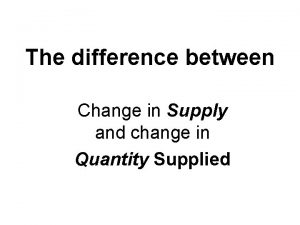Health Governance Presentation Outline Governance Health Governance Determinants





























- Slides: 29

Health Governance

Presentation Outline • Governance • Health Governance • Determinants of Health Governance • Health Governance Factors – PESTEL • Challenges in Health Governance • Prospects for Improving Health Governance

Governance and Good Governance? • Governance is not the same as ‘Good Governance’ • Governance refers to the institutions, processes and traditions which define: • How power is exercised? • How decisions are made? • How the views of the citizens are taken into account? • It includes the structures, functions, (responsibilities), processes (practices), and institutional traditions that the institution uses to ensure accomplishment of the institutional mission • ‘Good Governance’ means achieving desired results and achieving them the right way, i. e. in ways that are consistent with the values of democracy and social justice

Governance -definition The World Bank defines governance as: • The traditions and institutions by which authority in a country is exercised • This includes the process by which governments are selected, monitored and replaced; • the capacity of the government to effectively formulate and implement sound policies; and • the respect of citizens and the state for the institutions that govern economic and social interactions among them.

Some Principles of Good Governance 1 • Transparency: Decision making processes and public institutions should be transparent • Participation: Extensive participation results in more trust, higher process-related and output qualities • Equal treatment: Abolishment of discrimination based on gender, race, religion or age • Accountability/Responsibility : Capacity for the delivery of quality of services, efficiency, sustainability etc. towards stakeholders and responsibility towards it.

"Governance for Health" is based on an understanding that health is a human right, as well as on the 'social determinants of health, ' or the notion that determinants and solutions for health often lie outside of the health sector. सव सथय ध र ३८ ३५, समबनध हक Ø न : शलक सव आध रभत सव सथय Ø आकसम क परतय भत सव सथय सव क Ø सवचछ ख नप न Ø उपच रक समबनधम सरसफ इम पहच प उन हक Ø सरकष त म ततव परजनन सव सथय तथ ज नक र तथ Health Governance Indicators • Policies, capacity, systems. • Transparency and accountability. • Regulation. • Empowered civil society. • Participation of private sector.

Governance in health sector • Governance in health sector can be broadly divided into two groups: 1) determinants of health governance; and 2) health governance performance indicators. • Determinants of governance (or rule-based indicators as they are sometimes referred to describe whether a procedure, regulation, policy or law exists, whilst a governance performance indicator assesses to what degree rules or policies have been followed and enforced.


Determinants of Health Governance 1) First, it is essential to adopt good governance across multiple levels, from local to federal. • Action to reducing health inequities would thus imply building strong, participatory and inclusive governance structures within and between all policy domains. • Integrated work between sectors; such as the housing-sector, finance, energy, water, education, employment and transport, are all important components in action on the social determinants of health 2) Secondly, good governance does not only apply for state actors, also for non-state stakeholders. • Government interaction is commonly central in influencing the policy domains, however, decision-making is taking part beyond –and withinborders meaning that the impact of other stakeholders (e. g. civil society, local communities, private sector, international agencies) are essential. • Civil society participation and community engagement in policy processes concerning public transport may for instance bring about fairer decisionmaking on issues related to health equity.

Governance Actors Governance Effectiveness Rule of Law Regulatory quality Corruption Control Government Participatory Management Civil Society Private Sector

Determinants of Health Governance (2) 3) Third, governance structures must make sure to include the voices of the most vulnerable and marginalized groups in decisionmaking, as they are more exposed to poor health and unequal distribution of resources. • Their inclusion will increase the likelihood of more equitable, health-promoting and inclusive laws and policies. • Besides, it is also central to map out the needs and patterns of discrimination in order to overcome these. 4) Fourth, transparency and accountability should be promoted in the decision-making processes and mechanisms, within as well as outside the health-sector. • Incorporating these is also a step towards minimizing the risk for corruption and exclusive states.

Health governance in nutshell Health related constitutional rights Health Services Curative Preventive Promotive Rehabilitative Palliative: care for the terminally ill and their families, especially that provided by an organized health service. All 3 Levels of Government

Health Governance Performance Indicators NHSP 3 - outcome 5: Improved sector management and governance • OP 5. 1: Ministry of Health and Population (Mo. HP) structure is responsive to health sector needs • OP 5. 2: Improved management of private sector • OP 5. 3: Development cooperation and aid effectiveness in the health sector improved • OP 5. 4: Multi-sectoral coordination mechanisms strengthened • OP 5. 5: Improved public financial management within Mo. HP

Health Governance Factors PESTEL analysis is a strategic tool to analyze the macro environment of the health governance that impact the macro environment of Healthcare

Political Factors • These are all about how and to what degree a government intervenes in the economy. • This can include – • • government policy, political stability or instability, foreign trade policy, tax policy, labour law, environmental law, trade restrictions and so on.

Economic Factors • Economic factors have a significant impact on health sector operation. • Factors include – • economic growth, • interest rates, • exchange rates, • inflation, • disposable income of consumers and businesses and so on. Per capita government Health Expenditure (2017/18) NRs. 1, 819 (US$ 17. 19). Out of pocket expenses is 55. 17% (2015/16 – Study report June 2018)

Social Factors • Also known as socio-cultural factors, are the areas that involve the shared belief and attitudes of the population. • These factors include – • population growth, • age distribution, • health consciousness, • career attitudes, • GESI and so on.

Technological Factors • We all know how fast the technological landscape changes and how this impacts the way we market our products. • Technological factors affect marketing and the management thereof in three distinct ways: • New ways of producing goods and services • New ways of distributing goods and services • New ways of communicating with communities

Environmental Factors • These factors have only really come to the forefront in the last fifteen years or so. • They have become important due to the • increasing scarcity of raw materials for industrial production, pollution targets, carbon footprint targets set by governments. • More and more consumers are demanding that the products they buy are sourced ethically, and if possible from a sustainable source.

Legal Factors Legal factors include – • health and safety, • equal opportunities, • advertising standards, • consumer rights and laws, • product labelling and product safety.

Challenges in Health Governance 1. Inheritance of structural inequities • New federal governance inherits some structural challenges from highly centralized governance in the past which have led to multitude of inequalities in health indicators across different socio-economic groups and geographical regions. • Poverty level varies across provinces with Karnali province and province 2, being poorest in socio-economic indicators. • Availability of resources including the distribution of health facilities and human resources is not equitable at the provincial level. For instance, 11 central hospitals under Ministry of Health and Population are in Kathmandu valley (Province 3) while the distribution of private hospitals and medical colleges depicts similar scenario with most of them centered in Kathmandu and urban areas. • Health facilities in the rural areas are under-resourced and crippled with geographical hindrances and poor retention of health workers. • Federal governance would require management of existing human resource for health at national and sub-national levels. The current human resource problems related to availability and distribution might pose difficulty for effective functioning of health system.

2. Health as a conflicting priority • Health might be a conflicting priority at the local level government with the local body officials showing more interest in infrastructure development like roads, electricity and water supply. • Though the infrastructure development helps to set the foundation of the public health, curtailing health sector resources to other sectors will jeopardize the decades of achievement in health sector. • Similar experience from Kenya suggest that local governments were influenced by power and politics with community based health interventions given low priority after devolution.

3. Health financing • Health sector expects 10% budget to accomplish its goals • The budget allocated to the health sector in the last few years is around 67% • It affects the health service delivery system at all levels. • In the changed federal context, financing health system at national and sub -national levels will be a challenge for the country in the absence of a robust health financing strategy. • Sub-national governments, in addition to receiving budget from the central government, can generate revenue by expanding tax structure. • Introduction of health insurance program was a welcome move in the country for pooling risks but remained insufficient thus far to achieve universal health coverage as health system suffers from systemic challenges mainly inequitable distribution of health resources and compromised quality of health services.

4. Performance of health system and quality • According to The Lancet Global Health Commission, deficit in quality health care contribute to 60% of total deaths related to health care while the remaining is related to non-utilization of health services. • The commission has further stressed on redesigning service delivery where maximization of health outcomes is focused over geographical access to health services. • Sadly, in Nepal, health system challenges and discussions are dominated by access related problems while quality component of health care has been overlooked. • With local governments taking the gear of health system, initiatives to improve health system performance need to focus on quality improvement strategies, as well as improving local level planning, implementation and evaluation of health programs. 5. Etc.

Prospects for Improving Health Governance 1. Translating policy into practice • The health system of Nepal is currently guided by Constitution of Nepal 2015, National Health Policy 2014 and Nepal Health Sector Strategy (2015 -2020). • These three policies in turn are guided by the principles of human right, access, quality, health sector reform and multi-sectoral approach. • The federal governance will provide an opportunity for transforming these policies into practice, as well as provide more authority to sub-national governments in sharing and control of resources. • However, sub- national governments need to prioritize investing in their key health priorities as well as closely align with the central governments for implementing national health policies and programs. For example, addressing undernutrition could be a priority for Province 2 (29% female and 23% male are too thin for their height), where as addressing overweight/obesity can be a priority for province 3 (35% female and 24% male are either overweight or obese). • The Demographic and Health Survey 2016 has highlighted geographical disparities in health indicators as well as displayed a need for local and provincial government to narrow these disparities immediately.

2. Local governments take charge for health • Presence of local government under federalization has raised hope for strengthening health system in Nepal. • Local governments are expected to engage in health planning and management, and assuming responsibility for health of the population by ensuring provision of quality services and allocation of resources to the health sector. • Local level governments will be responsible for ensuring basic health services, monitoring social health protection measures including health insurance and addressing equity issues by focusing on underserved populations which will be detrimental to achieve universal health coverage. • A functional health system managed by local level governments will thus be a sustainable measure to ensure the spirit of federal governance.

3. Health as development agenda • Ministry of Social Development at the province level has been assigned to oversee sectors such as health, education, women and child welfare, labor, culture and social protection. • This will be an opportunity to drive health as a development agenda, as well as materialize the principle of health beyond health. • Further, multi-sectoral planning would minimize resource duplication and integrate health across different sectors. • The same applies to planning at local level where health could fit as a social agenda with local level governments taking ownership to address the health priorities which were formerly owned and addressed centrally.

Strengthening health care • Government of Nepal has envisioned for establishing municipal hospital in each local level government and health unit at ward level. • However, building health infrastructure alone will not be enough to bring services closer to the population as health is affected by complexities both inside and outside of health sector. • Human resources with appropriate skill mix, use of appropriate technology and information system, strong leadership and governance and community participation need to be well in place to deliver quality and community trusted services and promote healthy lifestyles. • Importantly, it is necessary to take into account the broader social determinants of health while planning for health interventions. • The key to building health systems in Nepal would be strengthening primary health care for which the role of local level governments would be important.

Thank You
 What are the 6 main social determinants of health?
What are the 6 main social determinants of health? Physical environment determinants of health
Physical environment determinants of health It in a sentence
It in a sentence Hackathon presentation outline
Hackathon presentation outline Presentation outline slide
Presentation outline slide Presentation outline example
Presentation outline example Ppt topics
Ppt topics Introduction to world wide web
Introduction to world wide web Nst internship
Nst internship Project seminar presentation
Project seminar presentation Training presentation outline
Training presentation outline Mgckey
Mgckey Project presentation outline
Project presentation outline Brow presentation birth
Brow presentation birth Leopold maneuver
Leopold maneuver What are the determinants of market structure
What are the determinants of market structure Acdc copyright
Acdc copyright Non price determinants of supply
Non price determinants of supply Non price determinants of supply
Non price determinants of supply Determinants of demand
Determinants of demand Non price determinants of supply
Non price determinants of supply What are the determinants of market structure
What are the determinants of market structure Social determinants of personality
Social determinants of personality Les déterminants synthèse
Les déterminants synthèse Determinants of pes
Determinants of pes Concepts of organizational behavior
Concepts of organizational behavior 3 by 3 matrix
3 by 3 matrix Characteristics of ihrm
Characteristics of ihrm What are the 5 determinants of price elasticity of demand
What are the 5 determinants of price elasticity of demand What are the 5 determinants of price elasticity of demand
What are the 5 determinants of price elasticity of demand





















































